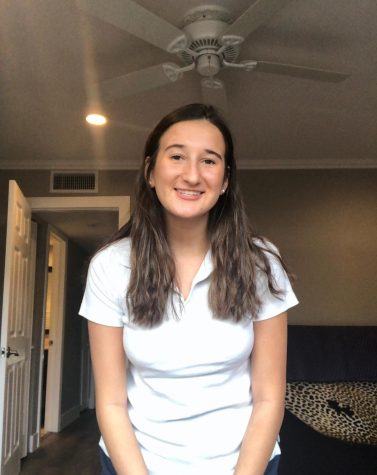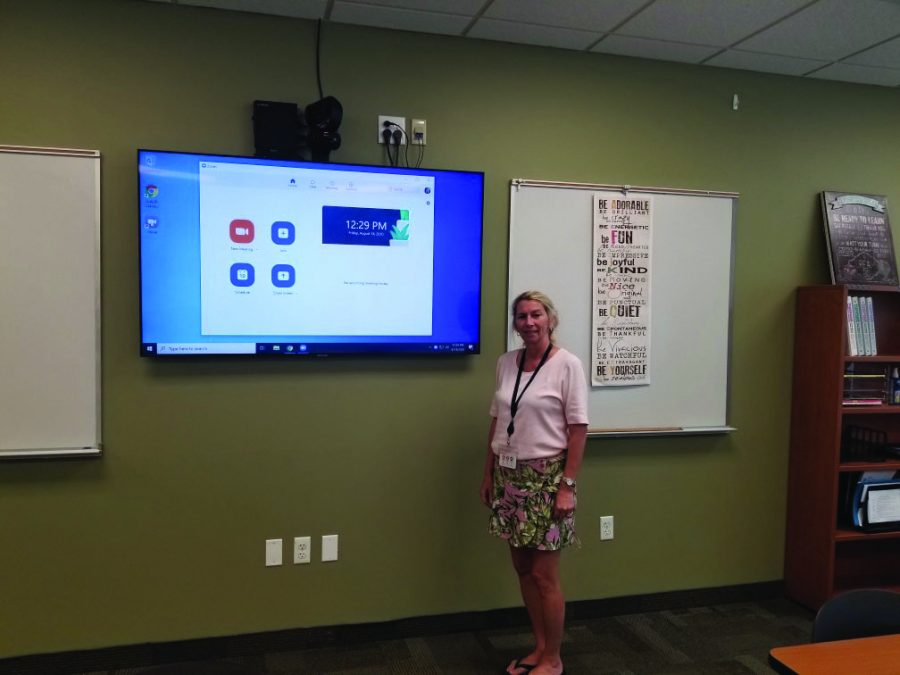New Technology Improves Remote Learning During COVID-19
Mrs. Laura Priola stands next to new technology in the classrooms.The School installed a number of new features to make remote learning easier.
Even before the School decided to begin the year in a completely virtual environment, the Technology Department implemented several changes to the Upper School’s classrooms with the goal of improving the quality of remote education.
Among the additions welcoming faculty back to their classrooms was a new video-conferencing system, The Connected Classroom, which consists of a high-definition robotic video camera, an integrated speaker and microphone, a large LCD screen, and a micro desktop computer to run the system.
According to Chief Technology Officer Mr. Russel Tepper, “The Connected Classroom will help our remote learners stay up to date in their studies, classroom discussions, and have a complete learning experience similar to as if they were physically present in the classroom.”
Upper School Technology Integration Specialist Mr. Matthew Morrow believes the changes will especially assist teachers in their online teaching endeavors.
“Teachers would have the ability to be socially distanced in their classroom and have access to more tools and technology than in their home,” Mr. Morrow explains. “For example, if your math teacher uses a whiteboard to the side of the interactive board, they can press a reset button on the remote to focus and frame the camera perfectly to that board.”
English Department Chair Mrs. Sharon Wendler agrees with Mr. Morrow that the new technology will aid teachers.
“We will be able to show what’s in our classroom (if we wanted to point out a particular poster or bulletin board or visual aid) or teach using the smartboard so that it’s more interactive,” Mrs. Wendler says. “Students can see us and read our facial expressions and see our gestures while also receiving instruction from the PowerPoint or the whiteboard.”
Even when the transition is made to integrate students back into the classroom, the new technology will still be extremely important, as it will make sure the students who opt to stay remote feel as if they are in class with their peers.
“We want to provide a similar experience to students who are physically in the classroom as well as the students learning remotely.” Mr. Morrow says. “Both sets of students will be hearing and seeing the same thing as each other at the same time.”
Class participation levels may also benefit from The Connected Classroom, as, according to Mr. Morrow, “remote students could be called on to answer questions and participate in classroom discussions, being heard and seen by the entire class regardless if they are on campus or at home.”
In addition to being added to classrooms in the Upper School, the new equipment has been installed throughout much of the Middle School and Lower School, so as to keep the entire school consistent with the changes made.
While the new system is yet to be tested by the masses, Mrs. Wendler expects it to be a success.
“The technology department, in the usual fashion, has thoughtfully selected the equipment needed to make our distance/in-person/hybrid learning environments as effective and beneficial as possible,” Mrs. Wendler says.

Hi! My name is Molly Fried and I'm a senior and the Co-Editor-in-Chief of The Pharcyde. I'm a member of the 14-Year Club here at Benjamin as well as the...


